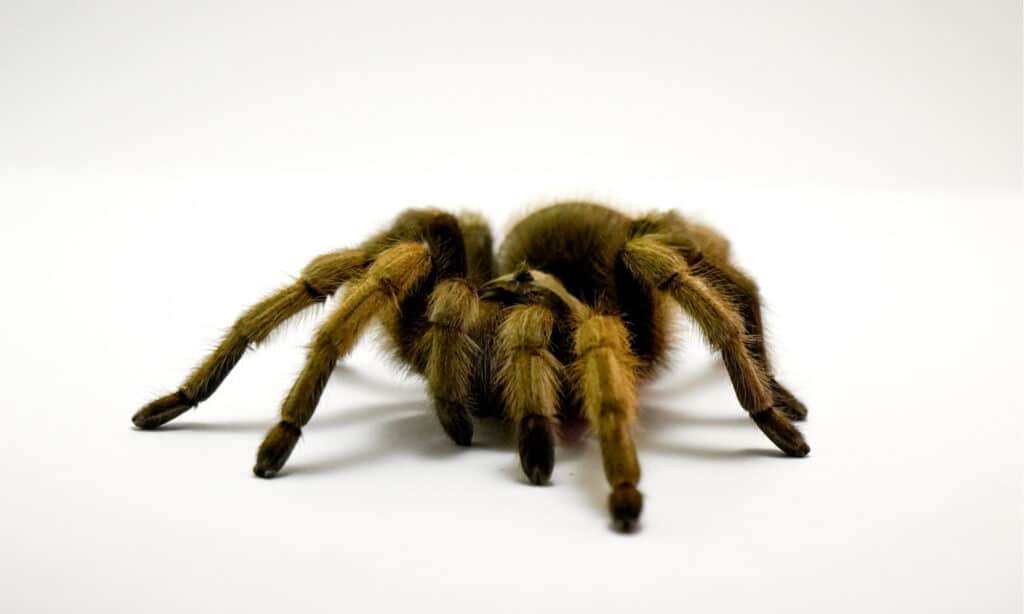Arizona Blonde Tarantula
Aphonopelma chalcodes
They are covered in thousands of fuzzy blonde hairs.
Advertisement
Arizona Blonde Tarantula Scientific Classification
- Kingdom
- Animalia
- Phylum
- Arthropoda
- Class
- Arachnida
- Order
- Araneae
- Family
- Theraphosidae
- Genus
- Aphonopelma
- Scientific Name
- Aphonopelma chalcodes
Read our Complete Guide to Classification of Animals.
Arizona Blonde Tarantula Conservation Status
Arizona Blonde Tarantula Facts
- Prey
- insects, beetles, grasshoppers, cockroaches, crickets, small lizards
- Main Prey
- beetles, grasshoppers
- Name Of Young
- Spiderlings
- Group Behavior
- Solitary
- Fun Fact
- They are covered in thousands of fuzzy blonde hairs.
- Most Distinctive Feature
- Thousands of tiny blonde hairs
- Other Name(s)
- Desert Blonde Tarantula, Mexican Blonde Tarantula
- Gestation Period
- 6-8 weeks
- Temperament
- Docile
- Habitat
- desert, scrubland, dry forest
- Predators
- lizards, snakes, birds, coyote, fox, tarantula hawks (wasp)
- Diet
- Carnivore
- Average Litter Size
- 600
- Lifestyle
- Diurnal/Nocturnal
- Number Of Species
- 1000
Arizona Blonde Tarantula Physical Characteristics
- Color
- Dark Brown
- Grey-Brown
- Blonde
- Skin Type
- Hairs
- Lifespan
- 8-10 years for males, 15-20 years for females
- Weight
- .5-.6 ounces
- Height
- 1-2 inches
- Length
- 2-3 inch long body, 5-6 inch leg span
- Age of Sexual Maturity
- 8-10 years
- Venomous
- Yes
- Aggression
- Low
View all of the Arizona Blonde Tarantula images!
Their bodies can get to be almost 3 inches long!
The Arizona blonde tarantula, also called the desert blonde or Mexican blonde tarantula, is a hairy spider found in Arizona, New Mexico, California and northern Mexico. They prefer dry arid climates and are frequently found in the Sonoran Desert. Their bodies and legs are covered in thousands of spiked hairs. They get their name from the blondish color of these hairs.
Amazing Arizona Blonde Tarantula Facts
- These spiders are some of the biggest spiders in North America.
- They have dark chocolate colored bodies covered in blonde hairs.
- Instead of spinning webs to catch prey they hide and ambush their prey.
- Females can lay 200-800 eggs at once.
- Arizona blonde tarantulas can live up to 20 years.
Arizona Blonde Tarantula Scientific name
The scientific name of the Arizona Blonde Tarantula is Aphonopelma chalcodes. Aphonopelma comes from the Greek word for “silent” or “sole of foot” and applies to the tarantulas that are found in North and South America. Arizona Blonde Tarantulas are also commonly called desert blonde and Mexican blonde tarantulas.
Arizona Blonde Tarantula Appearance

While spiders typically produce silk for webs from their abdomens, tarantulas produce the silk from glands in their feet.
©kenlai95/Shutterstock.com
The Arizona blonde tarantula is a dark chocolate or dark gray spider covered in tiny blonde (or golden) hairs. Their bodies can get to be 2.75 inches long and their leg span can be 6 inches making them about the size of the palm of your hand. Tarantulas are the largest of all North American spiders. They have eight long legs that are also covered in hair. Their bodies are made of the cephalothorax (head and thorax together) and the abdomen.
Arizona Blonde Tarantula Behavior
While spiders typically produce silk for webs from their abdomens, tarantulas produce the silk from glands in their feet. Arizona blonde tarantulas burrow holes in the ground and cover the entrance with a web of this silk. During the day they hide in these burrows and rest, coming out at night to hunt. They wait in the entrance of their holes for prey like insects, small lizards and crickets. If they find a cricket passing by, for example, they grab it with their front legs and immediately inject it with venom. The venom both paralyzes the prey and then proceeds to liquefy its insides. Then the tarantula can suck up the nutrients from the liquefied cricket.
Arizona Blonde Tarantula Habitat
Their name is a giveaway as to where they can be found, but besides Arizona they are located in southern parts of California, New Mexico and northern Mexico. They live in hot, dry deserts like the Sonoran Desert. They can also be found in scrublands and dry forests.
By burrowing into the sand they can help maintain their body temperature. They spend their days in their burrows and come out at night to hunt. Arizona Blondes are solitary creatures with only one tarantula in each burrow. They typically don’t wander far from their burrows except during mating season when the males leave their home in search of a mate.
Arizona Blonde Tarantula Predators and Threats
In the desert there are a few animals that prey on tarantulas. Even though they are venomous, the venom is not harmful to animals that eat them. Prey include larger snakes, large lizards, birds, coyotes and foxes. One of the biggest threats to the Arizona blonde tarantula is the tarantula hawk which is not a hawk but a wasp. These metallic blue and orange wasps have a brutal way of feeding their young (brutal for the tarantulas). They will sting a tarantula, paralyzing it but keeping it alive. The wasp then lays its eggs on the spider’s abdomen and buries the spider alive. When the wasp larvae hatch the baby wasp eat the tarantula alive! Sounds better to be eaten by a snake or lizard.
What Eats Arizona Blonde Tarantulas?
The predators of Arizona blonde tarantulas include snakes, lizards, birds, coyotes, foxes and tarantula hawks (a wasp). The tarantulas are most at risk of being eaten at night when they are most active. During the day they spend most of their time deep in their burrows out of harms way.
What Do Arizona Blonde Tarantulas Eat?
Arizona blonde tarantulas are carnivores and eat whatever comes by their burrows. They wait at the entrance of their burrow for something to pass by and then they snatch it. They will eat insects, grasshoppers, beetles, small lizards, cockroaches, crickets, mice and scorpions. Once they snatch their prey they inject it with digestive juices that liquefy the animal. Then they ingest the liquefied nutrients.
What is the Conservation Status of Arizona Blonde Tarantulas?
Arizona blonde tarantulas are not listed as threatened by the IUCN.
Reproduction, Babies, and Lifespan
Arizona blonde tarantulas are solitary animals that spend most of their lives alone. But during the mating season the males will leave their burrows in search of a mate. This is when there are more sightings of the tarantulas. Once the male finds a female’s burrow he essentially knocks on her door by using one of its arms to tap the ground outside her burrow. Then he must be ready to try to mate as well as fend for his life. The female is more interested in eating the male so that she can provide nutrients for the upcoming batch of tarantula babies.
Female tarantulas lay 200-800 eggs in one batch and seal them in a protective covering with their silk webs. The eggs grow for about two months and the mother tarantula watches over them. When they hatch they stick around for a couple of weeks where the mother continues to watch them before they all disperse to create their own burrows. The babies, called spiderlings, are not dark with blonde hair when they are born but all white. It takes a few days before they start to darken in color. They are equipped to eat the same food as adults but will learn to target smaller prey.
If the male gets away he can go on to mate with more than one female, while females will only lay eggs once a year. Males are typically 8-10 years old when they reach mating age and either die during mating or a few months after if they succeed at getting away. Females on the other hand can live to be 20 years old.
Population
There are around 1,000 species of tarantulas in the world. In Arizona there are around 30 different species that have been documented. Due to the nature of their desert habitat and underground lifestyle it is difficult to get an accurate population count. The Arizona blonde tarantula is not listed as threatened by the IUCN.
Similar Animals
View all 194 animals that start with AArizona Blonde Tarantula FAQs (Frequently Asked Questions)
Are Arizona blonde tarantula carnivores, herbivores, or omnivores?
Arizona blonde tarantulas are carnivores.
What states do Arizona blonde tarantula live in?
Arizona blonde tarantulas live in Arizona, California and New Mexico.
Are Arizona blonde tarantulas good pets?
Yes, Arizona blonde tarantulas are good pets for beginners. They are easy to care for, docile and the females live for 20 years or more.
Can you pick up an Arizona blonde tarantula?
Yes, you can pick up and hold an Arizona blonde tarantula. As pets they are easily handled and can spend time out of their enclosures.
Do Arizona blonde tarantulas bite?
Arizona blonde tarantulas can bite but it is rare for them the bite humans.
Are Arizona blonde tarantulas venomous?
Yes, Arizona blonde tarantulas are venomous but their venom is not harmful to humans. They rarely bite humans and they are very docile.
Do Arizona blonde tarantulas make webs?
Arizona blonde tarantulas do not make webs to catch prey, they do make webs to cover the entrance of their burrows.
Thank you for reading! Have some feedback for us? Contact the AZ Animals editorial team.


















